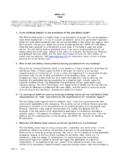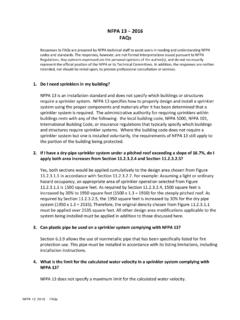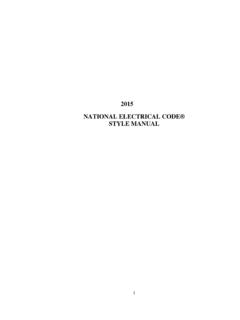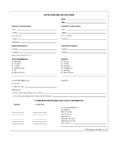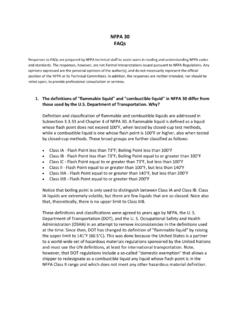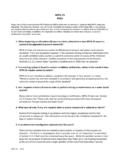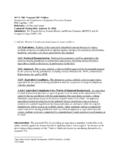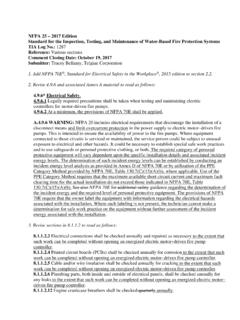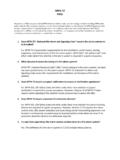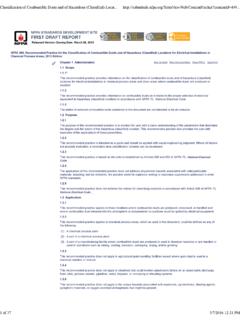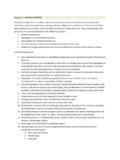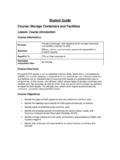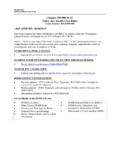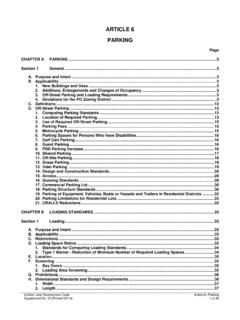Transcription of Medical Gas Cylinder Storage - nfpa.org
1 Medical Gas Cylinder StorageJanuary 2018 NATIONAL FIREPROTECTION ASSOCIATIONThe leading information and knowledge resourceon re, electrical and related hazardsThis material contains some basic information about nfpa 99, Health Care Facilities Code. It identifies some of the requirements in nfpa 99 as of the date of publication. This material is not the official position of any nfpa Technical Committee on any referenced topic which is represented solely by the nfpa documents on such topic in their entirety. For free access to the complete and most current version of all nfpa documents, please go to References to Related Regulations is not intended to be a comprehensive list.
2 The nfpa makes no warranty or guaranty of the completeness of the information in this material and disclaims liability for personal injury, property and other damages of any nature whatsoever, from the use of or reliance on this information. In using this information, you should rely on your independent judgment and, when appropriate, consult a competent professional. 2018 National Fire Protection Association 1 Medical GAS Cylinder STORAGEOne of the most common hazards in a health care facility is the storing and handling of Medical gas cylinders. nfpa 99, Health Care Facilities Code, provides guidance to keep patients, staff, and the public safe in facilities with these types of cylinders.
3 This document identifies the requirements of nfpa 99 that address the Storage and handling of these cylinders in a health care facility. This document also addresses what the hazards are, what kinds of signs and ventilation are required, and what precautions must be taken when working with these OF HAZARDST here are two types of hazards associated with Medical gas equipment: general fire and explosions, and mechanical issues such as physical damage to compressed gas cylinders. Fire and explosions can be caused by incidents involving oxygen, which is the most common gas used in health care facilities, and nitrous oxide, which is used frequently as an inhalation anesthetic.
4 These gases are oxidizers that, when present in sufficient quantity and concentration, form one side of the fire triangle. When the other two sides of the triangle, heat and fuel, are added, fire and/or explosion can result. The hazard is intensified because many materials commonly available in health care facilities that are not flammable in normal room air become flammable (or extremely flammable) when the concentration of oxygen is raised above that in room air. Nitrous oxide is not an oxidizer at room temperature, but it dissociates and forms oxygen under elevated temperatures that might be present during a fire. Compressed gas cylinders that sustain mechanical damage can also be a hazard.
5 Gases inside cylinders are generally under high pressures, and the cylinders often have significant weight. The cylinders can cause injuries directly due to their weight and inertia. Damage to the regulators or valves attached to a Cylinder can allow the escaping gas to propel the Cylinder violently in a dangerous manner. The pin-index safety system and gas regulators can also suffer physical damage and cause hazards to patients if the wrong gas is Cylinder STORAGER equirements for the Storage of Medical gas cylinders depends on the volume of gas within the cylinders. The greater the volume, the more stringent the requirements for the Storage Greater than 3000 ft3.
6 This volume of gas must be stored in locations that include the following: Access to move cylinders and equipment on hand trucks Lockable doors or gates Minimum of two entries/exits (if outdoors and greater than 200 ft2) Enclosure of noncombustible construction (if outdoors) Interior finishes of noncombustible or limited combustible material (if indoors) Walls and floors with 1-hour fire resistance rating, and other openings with -hour fire protection rating (if indoors) Compliance with nfpa 70 , National Electrical Code , for ordinary locations 2018 National Fire Protection Association 2 Heated by indirect means Racks, chains, or other fastenings to secure cylinders from falling Electrical power from the essential electrical system Racks, shelves, and supports of noncombustible or limited-combustible material Electrical devices protected from physical damage Access for delivery vehicles and management of cylinders Regulation of temperature (less than 125 F.)
7 Over 20 F for nitrous oxide and carbon dioxide) Ventilation (see page 4) Prohibition of motor-driven machinerySPECIAL CONSIDERATIONS/PRECAUTIONS FOR Cylinder STORAGEIn addition to the criteria for Storage locations are numerous other precautions that must be observed in the use and handling of cylinders. Small-size cylinders (A, B, D, or E) that are in use are not considered to be in Storage . Cylinders that are in use must be attached to a Cylinder stand or to Medical equipment designed to receive and hold cylinders. Small-size cylinders that are available for immediate use are not considered to be in Storage . Cylinders cannot be chained to portable or moveable apparatus.
8 Storage must be planned so that cylinders can be used in the order in which they are Between 300 ft3 and 3000 volume of gas must be stored in locations that are outdoors or in an interior enclosure of noncombustible or limited combustible construction. Indoor locations must include the following: Restriction of oxidizing gases from being stored with any flammable gas, liquid, or vapor Separation of oxidizing gases from combustibles or flammables by: A minimum distance of 20 ft A distance of 5 ft where the entire Storage location is sprinklered A gas cabinet constructed per nfpa 30, Flammable and Combustible Liquids Code Regulation of temperatures Appropriate restraints Cylinder valve protection caps Smoking, open flames, electric heating elements prohibited from location and within 20 ft outside locationVolumes Less than 300 ft3.
9 Cylinders containing this volume are not required to be stored in an enclosure. Precautions for handling the cylinders must still be observed. 2018 National Fire Protection Association 3 Where empty and full cylinders are stored together, empty cylinders must be segregated from full cylinders. For cylinders with internal pressure gauges, the facility needs to establish a pressure at which the cylinders will be considered empty. Empty cylinders must be marked. Cylinders stored in the open (outdoors) need to be protected from weather keep personnel safe while they work in locations with increased hazards, appropriate signage is required. Precautionary signs must meet the following requirements: Signs must be displayed on each door or gate of the Storage room or enclosure.
10 Signs must be readable from a distance of 5 ft. Signs must include the following language at a minimum:CAUTION: OXIDIZING GAS(ES) STORED WITHIN NO SMOKING If the facility does not prohibit smoking, additional precautionary signs indicating where oxygen is being administered must be provided. If the facility does prohibit smoking and signs are prominently spaced at all major entrances, the additional signage is not know which requirements apply to Storage locations, the volume of gas must be identified. This table extracts a portion of Table of nfpa 99 for a quick reference to determine the volume of gas in typical cylinders based on the gas of GasCylinder Style and DimensionNominal Volume ( ) Medical AirCarbon DioxideNitrous OxideOxygenB 3 in.
